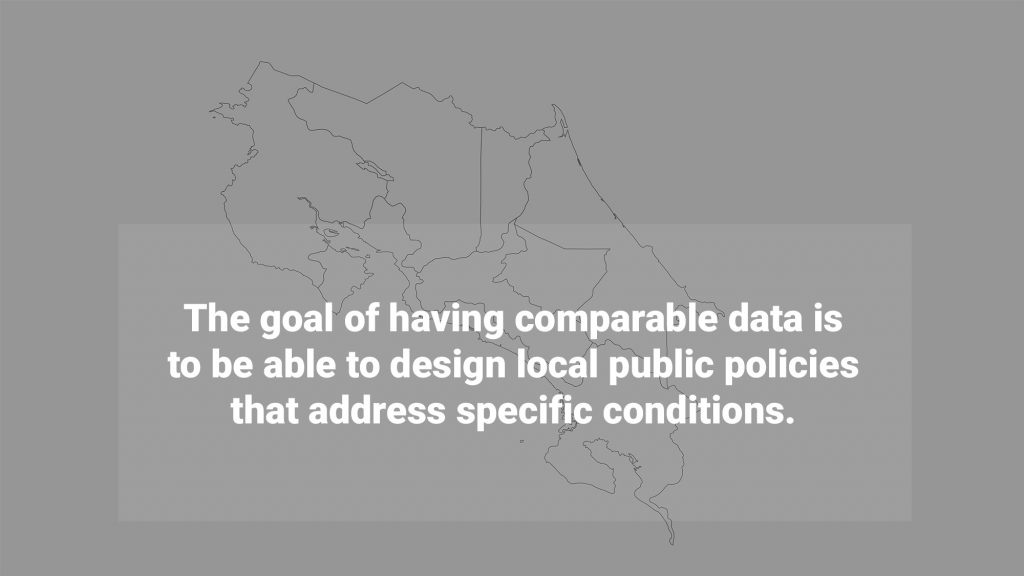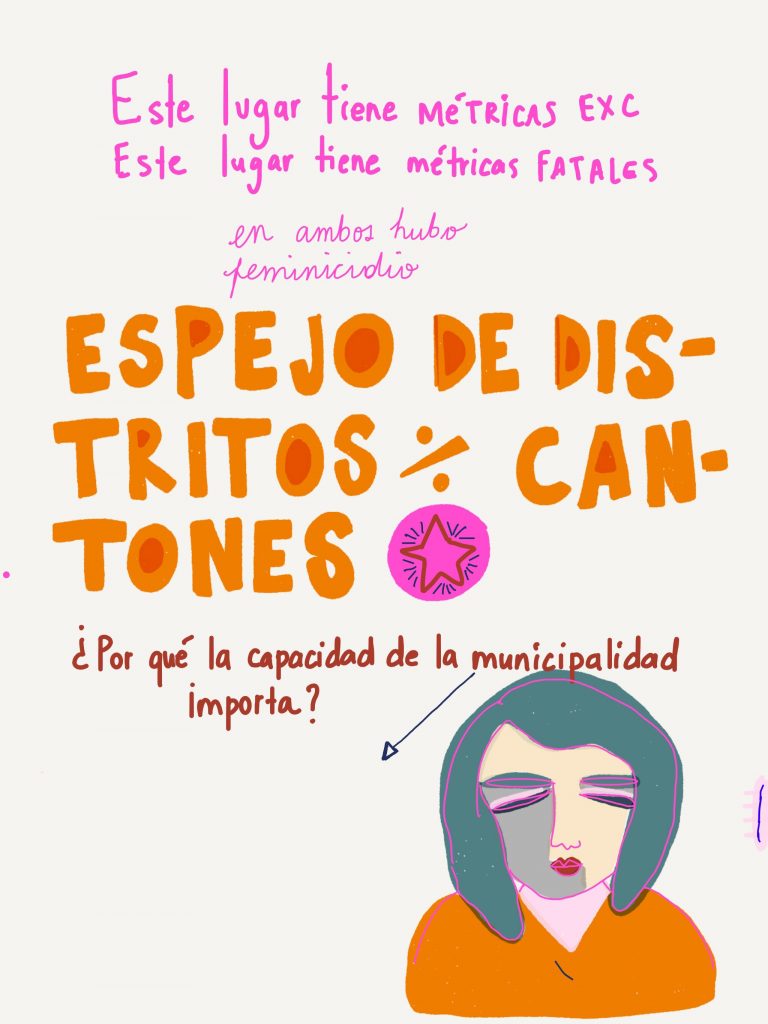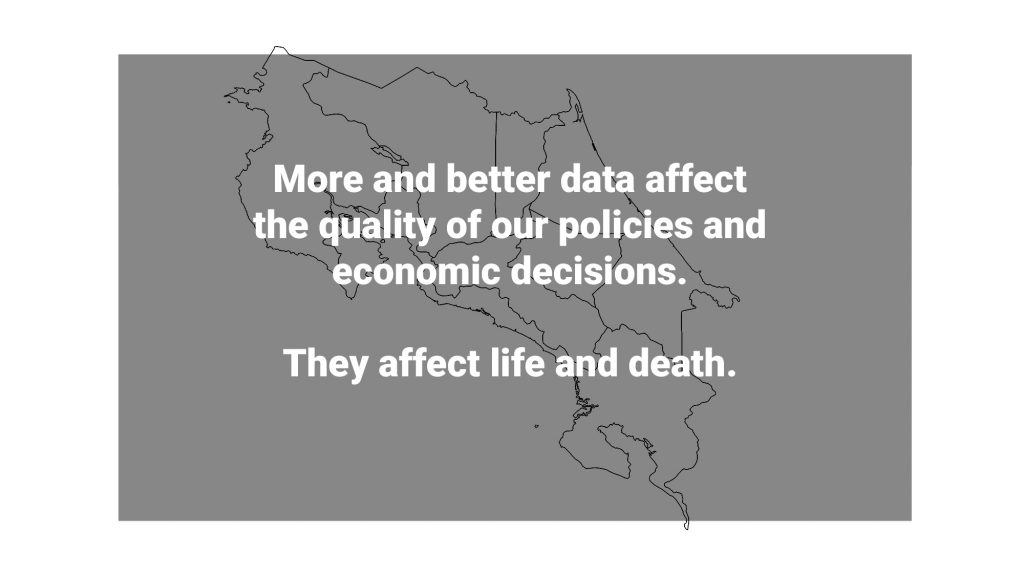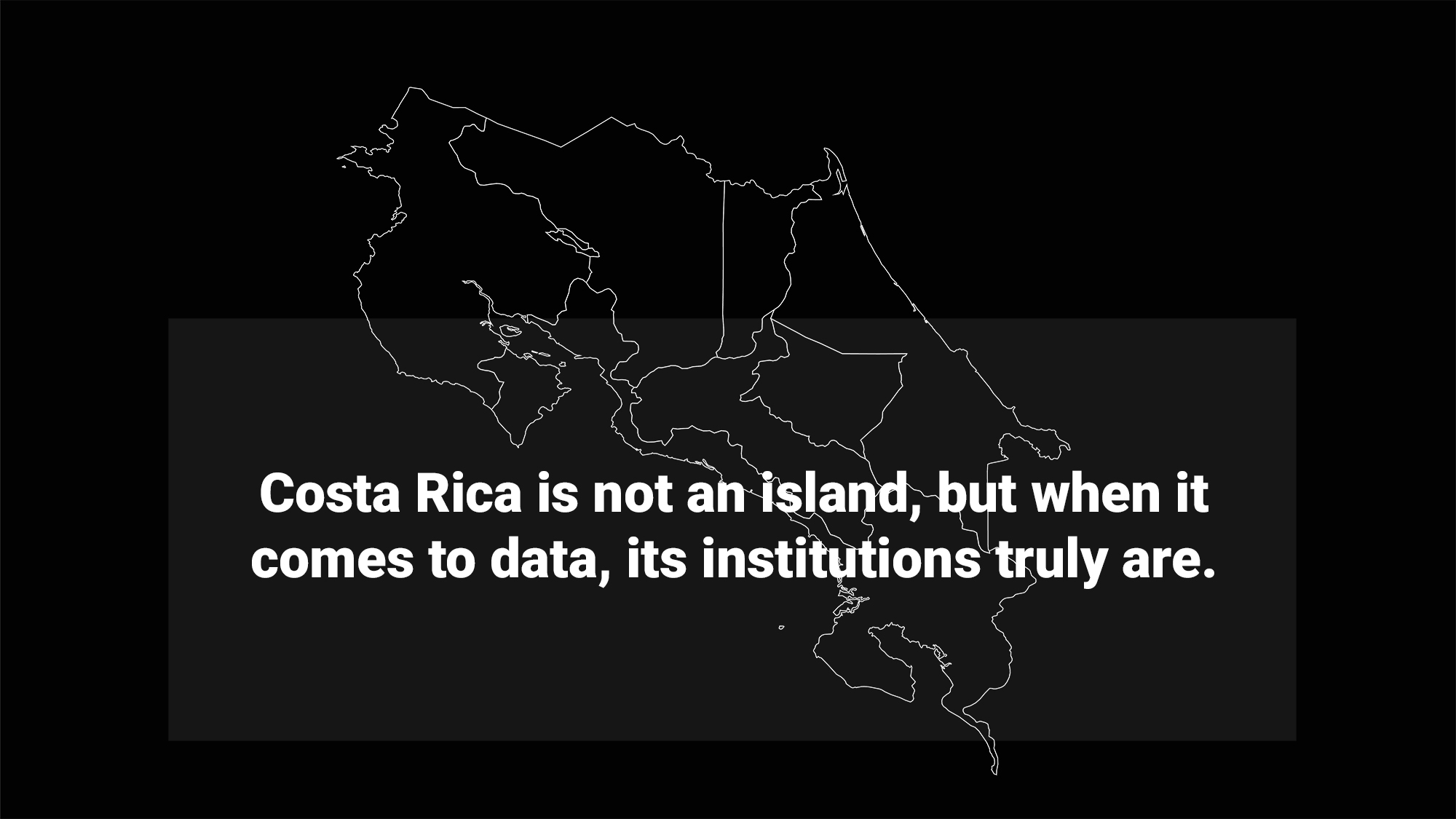During the last two years, Costa Rica buried 35 victims of femicide: 16 in 2019, and 19 in 2020. Those 35 cases occurred in 29 different cantons.
Could anyone foresee them? Most likely not.
Could someone do something to prevent them? Yes, if we look closely enough.
There is no single type of gender-based violence, nor is there a single way it manifests. It is a complex issue for data analysis no matter what, but in Costa Rica we add another challenge: the thematic specialization of the government means that different institutions deal with and understand problems in different ways. Each of them has the power to divide our national territory according to their criteria, unrelated to others.
This makes things very hard for people like me who want to compare data between institutions.
How does this happen? Costa Ricans learn in school that Costa Rica is divided into seven provinces. Each province, in turn, is divided into up to 20 cantons, or municipalities; each canton is divided into districts, from 1 to 16 of them. It is a logical and convenient ordering system. But our institutions don’t take advantage of this.
Each public entity has the power to define its own working regions. Because there are no universal criteria, the health areas for Costa Rican Social Security, or Caja, do not match the court divisions of the Judicial Branch. What’s more, neither of these two institutions’ regions are comparable to the socioeconomic regions used by the National Institute of Statistics and Census (INEC). Each institution is its own island of knowledge: useful, but with limited options for cooperation.
Many people think that statistics and data are useful only to a small group. These are numbers quoted by experts on television or politicians making speeches. But this is one use for data: numbers also allow us to measure the magnitude of certain phenomena. If we put together several data sets, we can build an articulated and systemic panorama of a specific phenomenon. Understanding the problem at that level can allow solutions to emerge. In the case of femicides, these solutions could save women’s lives.
Femicides are the result of gradual processes of violence: there is an unequal relationship between the man and the woman he decides to kill. The signs of this are often seen only by the couple themselves and some who are close to them. However, it is possible to see broader patterns through working with statistics that can indicate where to intervene.

If all public institutions collected their data using consistent geographic divisions, we could do much more complex and specific data analysis. We could move from general ideas or biases to decision-making based on relevant evidence. Instead of reacting to femicides, we could address the situations that put women at risk. We could not only reduce violent crime, but also improve the quality of life of thousands of people.
Because the data was scattered across institutions, I found that in order to explore this topic for El Colectivo 506, I had to put together my own way to understand how violence against women and other indicators in our country are related. Some analyzes were straightforward, because the databases were well organized. Others I had to do by hand, in a notebook, while looking at the map of Costa Rica.
This is 2021. This kind of analysis should be easy for anyone to pull up and view, through the help of a computer.
The good news is that while no one has standardized the way data is collected, the evidence is there, albeit scattered. If organizations cannot work together to analyze a problem, they cannot work together to hide it.
A complex exercise
In Costa Rica, “femicidio,” or femicide, is legally defined as the violent murder of a woman because she is a woman, in which there was some unequal power dynamic. The slightly different term “feminicidio” is often used to describe a death that followed previous aggressions and that demonstrates inaction by the State to guarantee the safety of women.
Femicide is a process of violence that progresses over time. The way to prevent femicides in the future is to examine how women’s rights are being violated in the present. In other words, we need to study risk factors that increase the possibility that women will experience violence at the hands of their partners. But how can we identify those factors?
A Spanish university reviewed 33 studies to determine 46 risk factors for violence against women in couples. Of these 43 indicators, my research allowed me to link 18 of them to Costa Rican public data. I incorporated account geographic differences into that process in order to compare regions.
In addition to those 18 indicators, I would have liked to include others from the list of 43, such as indicators related to national development or the political rights of women. However, in Costa Rica, these indicators are measured only at the national level, averaging the very disparate realities within our territory. Country indicators for compliance with the Sustainable Development Goals do this as well, making it hard to see what happens outside the central region.
Once I identified the 18 factors, I reviewed the indicators from 2015 to 2019. This allowed me to calculate an average value per year and identify regions whose reported values were higher than the national average for each of the years. Finally, I compared these results with the number of femicides reported or pending classification from 2019 and 2020.
When analyzing the past two years’ 35 femicides by canton, we see that 29 of them occurred in 23 cantons with the worst scores compared to the national average in four metrics of the 18 mentioned, related to interpersonal violence against women: the Cantonal Human Development Index (HDI), the percentage of women with some type of secondary education, the number of marriages with underage women, and the proportion of women under 35 years of age.
What could this data mean? If the vast majority of these femicides occurred in cantons that present negative values for these four indicators, can this information give us input on the reality of women in those cantons? Can we work to prevent violence against women based on this information?

Education and employment
An important component of any territorial study in Costa Rica is the Cantonal Human Development Index (IDHc). This indicator is complex. To obtain it, indicators for life expectancy, access to education, and a decent standard of living are averaged for each canton. Statistically speaking, the IDHc is a reflection of how long people are expected to live. It also reflects their ability to achieve an adequate quality of life by having the tools to get a job and therefore meet their needs.
Education is a key variable here. Data from the Ministry of Public Education (MEP) reveal some information about education in Costa Rica, such as that between 2015 and 2020, more women than men enrolled in educational programs. However, the data does not say anything about the people who did not enroll, nor does it reflect the quality of the training received by the people who did enroll. One piece of data that we can analyze at the cantonal level, and which I included in my analysis, is the percentage of women with some type of secondary education: in the cantons with femicides in Costa Rica, that percentage is 39%.
Employability depends on this access to education, among other factors. And the literature shows, again and again, that employability is key to preventing violence against women.
Studying employment is a way to study financial independence. A person with a job can avoid asking someone else for money to meet basic needs. It also means that the person is not dependent on public assistance programs, funding that could run out.
Violence grows over the years
The data at the national level shows that reports of violence against women have increased substantially between 2015 and 2019. The metric for this is the number of cases that enter the legal system where gender is a factor, specifically domestic violence, sex crimes, and alimony cases. The increase in cases processed by the Judicial Branch in recent years may suggest either a higher incidence of these crimes; or a greater percentage of crimes reported; or both.
One disadvantage of this information is that the Judicial Branch organizes the number of cases handled according to geographic divisions that are different from those were learned in school. Instead of dividing territories by canton and district, it uses “judicial circuits” and “juzgados.” Although these can be grouped by province, cantonal indicators can not be compared to them so that we can understand trends in specific municipalities.
| Cases processed by the Judiciary for… | 2015 | 2016 | 2017 | 2018 | 2019 |
| Domestic violence | 276 | 510 | 862 | 912 | 912 |
| Sex crimes | 6617 | 6748 | 8746 | 1011 | 392916 |
| Alimony | 171 546 | 172 045 | 170 764 | 178 187 | 185 689 |
As the divisions used by the Judiciary do not correspond to the administrative division of the country, we cannot link the incidence of crimes with other geographic variables, preventing us from analyzing which factors could be aggravating these cases.
In the end, the goal of comparable data is to be able to design public policies at the local level that address specific conditions. For example; If a canton, or even a district, has low female participation in the labor market, and we also know that many of those women depend on alimony, we can generate local and easily accessible programs to promote training for these women and help them get a job.
By generating these policies in a targeted way, we would improve the lives of these women and their families. However, the data might also show, over time, that we also managed to reduce the violent deaths of women.

Better measurements of violence against women: a national decision
It is unusual for those who practice journalism, particularly data journalism, to write in the first person. However, to tell this story, I realized that I had to break that rule. In this case, it is not only the conclusion that matters: it’s everything that was necessary to do to reach it.
While I hoped to use these last few lines to recap the most important findings in a conclusive way, it’s just not possible. Nor would it be wise. There is more value in sharing what went wrong, what was frustrating, and what could be improved.
In that frustration, I looked for examples in other parts of the world where data related to this topic is handled differently, in hopes of reducing violence. An interesting and recent case in Spain (2020) used machine learning, a type of automated analysis based on artificial intelligence so that a system “learns” from a set of data and reaches better conclusions than a human being can. This allows authorities to react more quickly to changes in statistics, which is essential in complex and changing issues such as violence against women.
However, the Spanish case is not replicable in our country due to the limitations of our databases, particularly geographic fragmentation. The other limitation is that some values are measured only once a year or even up to every five years, so the prediction would not be as accurate as it would be if it were measured by month or quarter.
I’m grateful that the documents of the Judicial Branch’s Observatory of Gender Violence and Access to Justice allowed me to disaggregate data at the canton level and link cases of femicides to specific provinces or regions. However, I had to do this work by hand, carefully comparing multiple screens at the same time: on one the list of cases, on another the map of Costa Rica, on another my spreadsheet. That kind of manual work shouldn’t happen in data analysis.
There’s lots of room to improve the quality of the data we have in the country. For now, we have no choice but to work with the data we have. We can use regional and provincial indicators to narrow our analysis down geographically, and cantonal indicators to add a thematic dimension. Carrying out this multilevel exercise would have a positive impact: it could promote cooperation between neighboring territories. In the absence of provincial or regional governments, we can urge neighboring local governments to work for collective well-being and positively affect the lives of women.
But we must also work to achieve more ambitious changes that allow us to have more precise data that we can compare across institutions and subject to more complex data analysis methods.

How would Costa Rica change if the data of one institution could be compared with that of any other?
How would the country change if we had not only a National Statistics System, but also a joint effort between all the statistical departments of our public institutions to reconcile the way in which each of these institutions measures its variables?
How would the country change if the Legislative Assembly allocated budgets for quantitative research so that surveys that are now done every five years could be carried out more frequently, and so that all institutions could take advantage of the data to design better strategies?
It doesn’t hurt to dream. In this case, dreaming is essential. More and better data would have an impact on the democratization of information. On the quality of our policies. On the quality of our economic and financial decisions.
On life and death.
Among everything we could achieve if we prioritized the conversation about this issue, we can also protect women’s lives and assert their rights. We have the evidence that those rights are being violated. The big question here is: how much longer will we wait before we change that?





